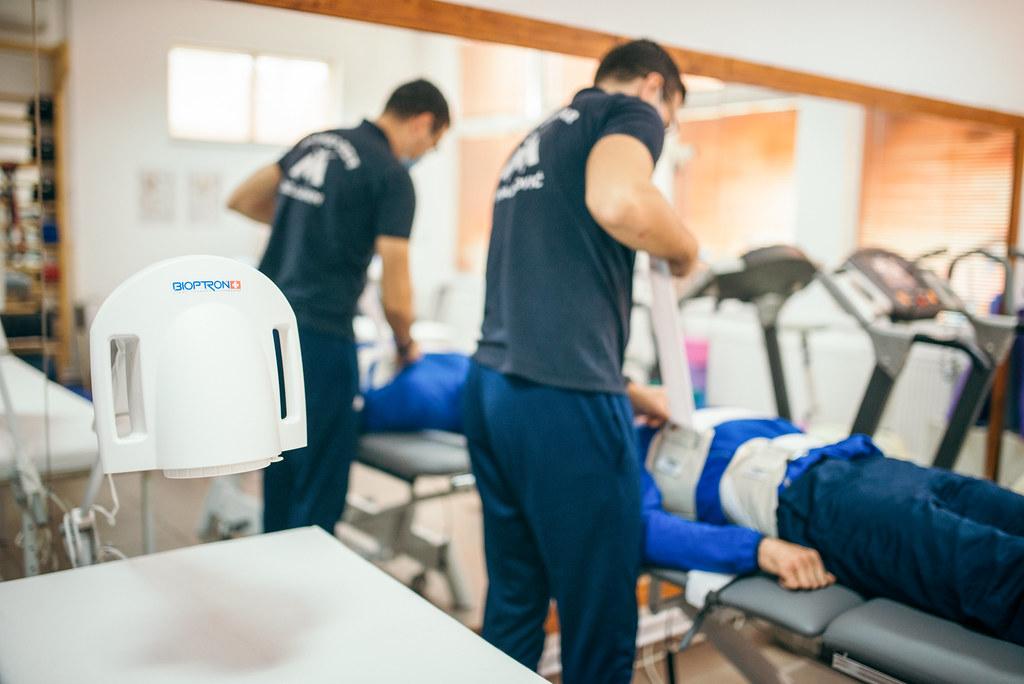Physical Address
304 North Cardinal St.
Dorchester Center, MA 02124
Physical Address
304 North Cardinal St.
Dorchester Center, MA 02124
Are you confused about the terms “physiotherapy” and “physical therapy”? You’re not alone! As a physiotherapist consultant, I often encounter individuals who use these terms interchangeably. However, there are subtle differences between the two that are important to understand in order to make informed decisions about your healthcare. In this article, we will delve into the nuances of physiotherapy and physical therapy, exploring their similarities, differences, and which may be the best fit for you based on your individual needs and preferences. So, let’s unravel the mystery together and find out if they’re really the same or not!
Physiotherapy and physical therapy – two terms that are often used interchangeably but are they really the same thing? Well, let’s dive into the nitty-gritty details to unravel the mystery behind these two seemingly synonymous terms.
First things first, let’s address the elephant in the room – the difference (or lack thereof) between physiotherapy and physical therapy. The short answer? There really isn’t much of a difference. Yep, you read that right! Both physiotherapy and physical therapy involve the treatment of a wide range of conditions through physical methods such as exercise, manual therapy, and modalities like ultrasound or electrical stimulation.
So, if they’re pretty much the same thing, why do we have two different terms for it? Well, here’s where it gets a tad bit interesting. The term “physical therapy” is more commonly used in the United States, while “physiotherapy” is the preferred term in other parts of the world like the United Kingdom, Canada, and Australia. It’s basically like the whole “potato-potato” situation – same thing, just different ways of saying it.
From my experience working in the field of physiotherapy (or physical therapy, if you prefer), I’ve come to realize that what truly matters is the quality of care and treatment that you receive. Whether you’re seeking assistance for a sports injury, post-surgery rehabilitation, or chronic pain management, what’s important is finding a skilled and compassionate therapist who can help you achieve your goals.
At the end of the day, whether you refer to it as physiotherapy or physical therapy, the aim remains the same – to improve your quality of life, restore function, and alleviate pain. So, if you’re in need of therapy for any physical ailment, don’t get caught up in the semantics. Instead, focus on finding a therapist who understands your needs and can provide you with the personalized care and attention you deserve.
In conclusion, physiotherapy and physical therapy – same same but different. Whether you choose to go for physiotherapy or physical therapy, what truly matters is the outcome – a healthier, happier you. So, don’t get bogged down by labels. Focus on your recovery journey, and remember that the most important factor in your treatment is the expertise and dedication of your therapist. Here’s to your health and well-being, whatever you choose to call it!
Physiotherapy and physical therapy are terms often used interchangeably, but there are subtle differences between the two practices. While both professions focus on helping patients improve their physical health and mobility, there are distinctions that set them apart.
Physiotherapy is more commonly used in countries like the United Kingdom, Australia, and Canada, while physical therapy is the preferred term in the United States. Despite the variation in terminology, both physiotherapists and physical therapists undergo similar training and education to provide rehabilitation services to patients.
The core principles of physiotherapy and physical therapy are rooted in the belief that movement is essential for optimal health and well-being. Both professions utilize a variety of techniques such as exercise, manual therapy, and education to help patients recover from injuries, manage chronic conditions, and improve their overall quality of life.
In my experience as a physiotherapist consultant, I have seen firsthand the transformative power of physiotherapy in improving the lives of children and elderly individuals. Whether it’s helping a child regain strength and mobility after a sports injury or assisting an elderly person in maintaining their independence, physiotherapy plays a vital role in enhancing physical function and promoting overall well-being.
While the terms may differ, the goal of both physiotherapy and physical therapy remains the same: to help patients restore function, alleviate pain, and improve their quality of life. Whether you choose to seek treatment from a physiotherapist or a physical therapist, rest assured that you are in capable hands and on the path to recovery.
In conclusion, while physiotherapy and physical therapy are not exactly the same, they share a common goal of promoting physical health and wellness. Whether you’re seeking treatment for a specific injury or looking to improve your overall mobility, both practices offer valuable benefits that can enhance your quality of life. So don’t hesitate to reach out to a qualified physiotherapist or physical therapist to begin your journey towards better health and well-being.
When it comes to the world of therapy, there is often confusion surrounding different terms and practices. One such area of uncertainty is the distinction between physiotherapy and physical therapy. Are they the same, or are there important differences to consider?
Physiotherapy and physical therapy are actually interchangeable terms used to describe a specialized form of therapy focused on improving movement, reducing pain, and restoring function in individuals. Both disciplines are designed to enhance a person’s quality of life and overall well-being. Whether you refer to it as physiotherapy or physical therapy, the goal remains the same: to help patients reach their maximum potential.
One crucial factor to consider is that physiotherapy and physical therapy are tailored to meet the unique needs of each individual. These therapies are not one-size-fits-all solutions; they are customized to address specific conditions, injuries, or limitations. By seeking out a qualified therapist, you can receive personalized care that is designed to unlock the secrets of your body’s potential and help you achieve optimal health.
It is important to remember that physiotherapy and physical therapy are not only about treating existing issues; they are also about preventing future problems. By working with a skilled therapist, you can learn valuable strategies and techniques to maintain your health and avoid injury. These sessions are not just about addressing current concerns; they are about investing in your future well-being.
In my years of experience at the Centre for the Rehabilitation of the Paralysed, I have seen firsthand the transformative power of physiotherapy and physical therapy. From children to the elderly, these therapies have the potential to make a significant impact on one’s quality of life. I have witnessed the remarkable progress and improvements that patients have made through dedicated therapy sessions. It is truly astonishing to see how the human body can heal and thrive with the right care and support.
In conclusion, while the terms may vary, physiotherapy and physical therapy share the same fundamental principles: to help individuals move better, feel better, and live better. By considering these essential factors and seeking out the right therapist for your needs, you can embark on a journey towards improved health and well-being. Don’t hesitate to explore the benefits of physiotherapy and physical therapy – your body will thank you for it.
Physiotherapy and physical therapy are often used interchangeably, but are they really the same thing? Let’s dive into the details and unpack the differences between the two.
Physiotherapy tends to be the term used more commonly in countries outside of the United States, while physical therapy is predominantly used in the US. This subtle distinction might not seem like a big deal, but it’s important to understand the nuances when r needs.
Both physiotherapy and physical therapy focus on improving a person’s physical function, mobility, and overall well-being through targeted exercises, manual therapy, education, and modalities such as heat and ice. However, the specific techniques and approaches used may vary slightly based on the provider’s training and location. So, it’s crucial to do your research and identify which type of therapy aligns best with your needs and preferences.
As someone who has worked in the field of rehabilitation for over a decade, I can attest to the fact that both physiotherapy and physical therapy have their unique strengths and benefits. Physiotherapy, for example, often emphasizes a more holistic approach to healing, taking into account not only the physical aspects of a person’s condition but also their mental and emotional well-being. This can be particularly beneficial for individuals dealing with chronic pain or complex health issues.
On the other hand, physical therapy tends to be more focused on the physical aspects of rehabilitation, such as improving strength, flexibility, and range of motion. This type of therapy may be more suitable for individuals recovering from a specific injury or surgery, where a targeted approach to rehabilitation is needed.
Ultimately, whether you choose physiotherapy or physical therapy will depend on your unique needs, goals, and preferences. It’s essential to communicate openly with your healthcare provider and discuss what type of therapy aligns best with your situation. By making an informed decision, you can set yourself up for success on the path to better health and wellness.
In conclusion, while the terms physiotherapy and physical therapy are often used interchangeably, it’s essential to understand the subtle differences between the two to make an informed decision about your care. Remember, both types of therapy are designed to help you improve your physical function and overall well-being, so whichever path you choose, you’re taking a step towards a healthier, happier you.
Physiotherapy and physical therapy are terms that are often used interchangeably, but are they really the same thing? The answer may surprise you! Both physiotherapy and physical therapy involve the treatment of injuries, disabilities, and other physical conditions through exercises, manual therapy, education, and more. Physiotherapy is more commonly used in countries like the UK and Australia, while physical therapy is the preferred term in the United States.
When determining which therapy is best for you, it’s important to consider your specific needs and preferences. Physiotherapy tends to have a more holistic approach, focusing on overall wellness and prevention of future injuries. On the other hand, physical therapy may be more focused on specific injury rehabilitation and recovery.
My personal experience as a physiotherapist consultant has taught me that both physiotherapy and physical therapy have their own unique strengths and benefits. Physiotherapy, in my opinion, offers a more comprehensive approach to treatment, taking into account not just the physical aspects of a condition but also the mental and emotional well-being of the patient. This can be especially beneficial for children and elderly individuals who may require a more gentle and nurturing approach to therapy.
When it comes to choosing between physiotherapy and physical therapy, it’s important to consider your individual needs and goals. Consult with a healthcare professional to determine which therapy may be best suited for you. Remember, both physiotherapy and physical therapy are designed to enhance your overall well-being and quality of life, so you can’t go wrong with either choice!
Physiotherapy and physical therapy are two terms that are often used interchangeably, leading to confusion about whether they are the same thing. The reality is that they are essentially the same profession, just with different names in different parts of the world. Physiotherapy is the term more commonly used in countries like the United Kingdom, Australia, and Canada, while physical therapy is the preferred term in the United States.
It’s important to debunk the misconception that there is a significant difference between physiotherapy and physical therapy. Both professions involve the treatment of physical ailments, injuries, and disabilities through various techniques such as exercise, manual therapy, and education. Whether you see a physiotherapist or a physical therapist, you can expect to receive similar care and expertise to help you recover and improve your quality of life.
As someone who has worked in the field of physiotherapy for over a decade, I can confidently say that the goal of both physiotherapists and physical therapists is to help their patients regain mobility, reduce pain, and improve overall function. Whether you’re recovering from a sports injury, managing a chronic condition, or rehabilitating after surgery, a trained physiotherapist or physical therapist can provide the tailored care you need to achieve your goals.
One common misconception that I often encounter is that physiotherapy is only for athletes or those recovering from major surgeries. In reality, physiotherapy is a versatile field that can benefit people of all ages and abilities. Whether you’re a child with developmental delays, an older adult managing arthritis, or someone recovering from a stroke, physiotherapy can play a crucial role in improving your quality of life.
In conclusion, while the terms physiotherapy and physical therapy may differ depending on where you are in the world, the essence of the profession remains the same. Both physiotherapists and physical therapists are highly trained professionals dedicated to helping their patients achieve optimal physical health and function. So, whether you’re seeking treatment for a specific issue or simply looking to improve your overall well-being, don’t hesitate to reach out to a physiotherapist or physical therapist for expert care tailored to your needs.
Physiotherapy and physical therapy are often used interchangeably, but is there a difference between the two? Let’s uncover the hidden truths and unveil the secrets behind these two similar-sounding practices.
Physiotherapy and physical therapy essentially refer to the same type of treatment. In the United States, the term “physical therapy” is more commonly used, while “physiotherapy” is the preferred term in other parts of the world, including Canada, Australia, and the United Kingdom. So, it’s not merely a matter of semantics but rather a regional preference.
One of the main goals of physiotherapy/physical therapy is to help individuals recover from injuries, improve their physical function, alleviate pain, and prevent further disabilities. It’s a dynamic field that encompasses a wide range of treatment modalities, from exercise therapy to manual techniques like massage and joint manipulation.
In my experience as a physiotherapist consultant, I’ve seen firsthand the amazing results that physiotherapy can achieve for both children and elderly individuals. It’s not only about treating the physical symptoms but also about addressing the emotional and mental well-being of the patient. Physiotherapy is designed to enhance the overall quality of life and promote independence.
When it comes to choosing between physiotherapy and physical therapy, it ultimately comes down to personal preference and what works best for you. Some may find physiotherapy more appealing, while others may prefer the term “physical therapy”. Whatever the case may be, the goal remains the same: to help you achieve optimal health and wellness.
In conclusion, whether you opt for physiotherapy or physical therapy, rest assured that you’re in good hands. Both are backed by expert recommendations and have been proven to be effective in treating a wide range of conditions. So, don’t hesitate to take the first step towards a healthier, more active lifestyle with the help of physiotherapy/physical therapy.
Q: Is physiotherapy the same as physical therapy?
A: Great question! The terms “physiotherapy” and “physical therapy” are often used interchangeably, but they actually refer to the same type of treatment.
Q: So, what exactly is physiotherapy or physical therapy?
A: Physiotherapy, or physical therapy, is a form of healthcare that helps improve a person’s physical function and mobility through various treatments and exercises.
Q: What kind of conditions can physiotherapy or physical therapy help with?
A: Physiotherapy can help with a wide range of conditions, such as rehabilitation after an injury, managing chronic pain, improving balance and coordination, and more.
Q: How do physiotherapists or physical therapists help their patients?
A: Physiotherapists or physical therapists work with their patients to create personalized treatment plans that may include exercises, manual therapy, education, and other techniques to help improve their overall physical well-being.
Q: Can anyone benefit from physiotherapy or physical therapy?
A: Absolutely! Physiotherapy or physical therapy can benefit people of all ages and abilities, from athletes looking to recover from an injury to seniors looking to improve their mobility and quality of life.
Q: How can someone find a physiotherapist or physical therapist?
A: You can find a physiotherapist or physical therapist through a referral from your doctor, or by searching online for a reputable clinic in your area. Remember to always check the qualifications and credentials of the therapist before starting treatment.
Q: Is physiotherapy or physical therapy covered by insurance?
A: In many cases, physiotherapy or physical therapy is covered by health insurance, but it’s important to check with your provider to see what is included in your plan.
Q: Any final thoughts on the benefits of physiotherapy or physical therapy?
A: Physiotherapy or physical therapy can be a valuable tool in improving physical function, reducing pain, and enhancing overall quality of life. If you’re dealing with a physical issue, don’t hesitate to reach out to a qualified therapist for help.
In conclusion, despite the slight differences in terminology, physiotherapy and physical therapy actually refer to the same practice of using exercises and techniques to help patients regain movement and manage pain. Whether you’re seeking treatment for an injury, recovery from surgery, or management of a chronic condition, both physiotherapy and physical therapy can provide you with the personalized care and support you need to improve your overall physical well-being. So if you’re ever unsure about the terminology, just remember that both terms ultimately lead to the same goal of helping you move and feel better.